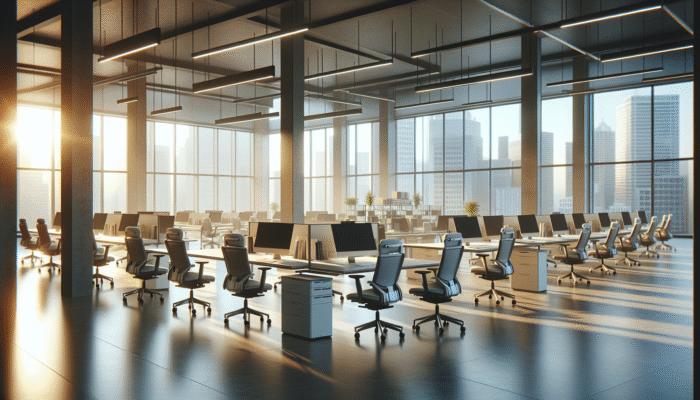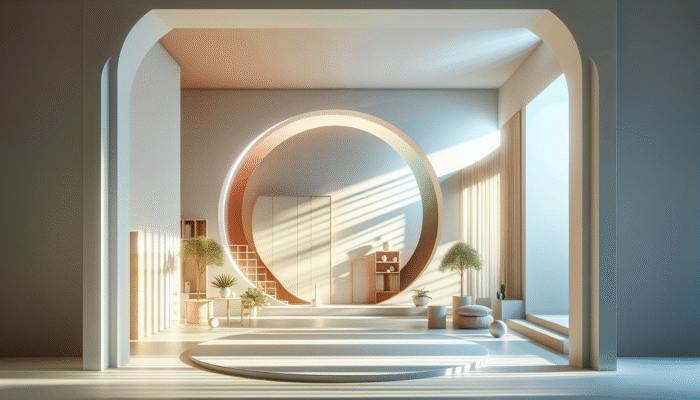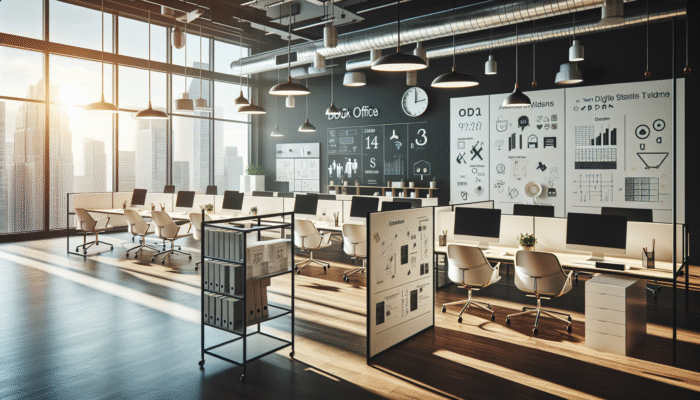Space for Movement and Functionality: Embracing Room to Thrive
Creating Functional Environments: The Importance of Adequate Space for Movement and Functionality
The essential concept of space, defined as “having enough room to move around and function,” is crucial for ensuring that our environments are both comfortable and functional. An efficient space design not only enhances aesthetics but also emphasizes functionality and the well-being of the people inhabiting it. In this discussion, we will delve into key principles that can guide the creation of optimal environments tailored to human needs.
Understanding Ergonomic Design: Tailoring Space to Human Needs

Ergonomic design is fundamental in creating spaces that are not only visually appealing but also adequately meet human requirements. By considering factors such as posture, mobility, and interaction, designers can establish spaces that minimize physical and mental stress. An ergonomic environment is crafted to support the natural movement of the body, enabling individuals to engage in their daily activities without limitations.
For instance, in an office setting, the arrangement of furniture should facilitate easy access and mobility. Adjustable chairs, height-variable desks, and open layouts can promote a healthier and more efficient workflow. Moreover, lighting plays a critical role; natural light can enhance mood and focus, while inadequate lighting can lead to fatigue and irritation.
Furthermore, ergonomic design transcends mere physical comfort. It also encompasses the creation of an environment where individuals feel safe and productive. By incorporating elements such as proper acoustics and climate control, we can significantly enhance the overall user experience in any given space.
Maximizing Functionality: The Power of Multifunctional Spaces
Versatility is key in space design, particularly in areas where room is at a premium. Multifunctional spaces allow users to make the most of every square meter, adapting to various activities and needs. For example, a living room that doubles as an office or a bedroom that transforms into a study area can be effective solutions for maximizing functionality.
To achieve this, it is essential to choose furniture that is flexible and easy to move. Sofas that convert into beds, folding tables, and modular shelving units are just a few options that can help transform a space. Additionally, using room dividers can define areas without the need for walls, allowing a single space to serve multiple purposes.
The key to creating multifunctional spaces lies in careful planning. By considering the range of activities that will occur within the area, designers can craft tailored solutions that meet the evolving needs of users. This approach not only maximizes functionality but also promotes a more balanced lifestyle by enabling individuals to engage in various activities in one location.
Innovating with Technology: Enhancing Space Efficiency through Modern Solutions
Technology is revolutionizing our perception and utilization of space, defined as “having enough room to move around and function.” From interior design applications to smart devices, technological innovations are facilitating more efficient use of space. For instance, 3D modeling tools allow designers to visualize a space before making alterations, optimizing layout and usage effectively.
Smart home technology is transforming residences and offices by integrating systems that control lighting, temperature, and security. These systems not only enhance energy efficiency but also empower users to tailor their environments to their personal preferences. Moreover, technology has given rise to intelligent furniture that can automatically adjust to user needs.
Additionally, communication and collaboration technologies have redefined team dynamics. Digital tools enable individuals to work more collaboratively, regardless of their physical location, reducing the necessity for large office spaces and encouraging a more efficient use of available spaces.
The Psychology of Space: Its Impact on Our Well-Being

The concept of space, or “having enough room to move around and function,” not only influences our physical comfort but also significantly affects our mental health and overall well-being. The psychology of space examines how our environment impacts our emotions and behaviors, making it a critical aspect to consider in any design process.
Open vs. Closed Spaces: Their Effects on Mental Health
The arrangement of spaces can influence our mood, making the choice between open and closed environments vital. Open spaces often encourage collaboration and communication, fostering a dynamic and stimulating atmosphere. However, they can become overwhelming for some individuals, particularly in noisy or chaotic settings.
Conversely, closed spaces can provide a sense of safety and privacy, which can be beneficial for concentration and individual work. The goal is to strike a proper balance that allows individuals to enjoy the best of both worlds. By incorporating rest areas and quiet zones into open spaces, we can provide a sanctuary where individuals can recharge and focus.
Moreover, it is crucial to consider how lighting and color within a space can affect our well-being. For instance, natural light is essential for regulating our sleep-wake cycles, while warm colors can create a cozy and relaxing atmosphere. When designing spaces, these variables must be factored in to create an environment that promotes mental and emotional health.
Personal Space Theory: Defining and Respecting Boundaries
Personal space theory pertains to the comfortable distance individuals prefer to maintain between themselves in various social contexts. Respecting these boundaries is essential for cultivating a harmonious atmosphere. In a work environment, for example, proximity to others can affect comfort and productivity. Designs that allow for some separation, such as partitions or dividers, can help define each individual’s personal space.
Additionally, it is vital to consider how culture influences the perception of space, defined as “having enough room to move around and function.” Different cultures have varying norms regarding personal space, and designers should be mindful of these differences when creating environments. In some cultures, physical closeness may signal friendship and intimacy, while in others, it might be interpreted as an invasion of privacy.
By fostering respect for personal space, we promote an atmosphere of trust and respect, contributing to a more positive and collaborative work environment. Ultimately, the design of spaces must account for these interpersonal dynamics to ensure that everyone feels comfortable and valued.
Enhancing Productivity: How Space Design Can Boost Workplace Performance

The design of a space significantly impacts the productivity of those who utilize it. Factors such as furniture arrangement, lighting, and acoustics can all influence work performance. A well-designed environment can minimize distractions and encourage focus, leading to increased efficiency and creativity.
Research has shown that workers in ergonomically designed environments experience higher satisfaction and productivity levels. Spaces that allow for personalization, such as the ability to adjust lighting and temperature, can help employees feel more comfortable and engaged in their work.
Moreover, including rest and recreation areas within a workplace can provide employees with opportunities to relax and recharge, contributing to long-term productivity. By considering how space design affects well-being and performance, employers can create a more effective and healthy environment for their teams.
Home Space: Strategies for Creating Functional Environments
A home should serve as a refuge, a place where individuals can relax and function optimally. To achieve this, it is essential to implement strategies that enhance the functionality and comfort of home spaces. From organization to decor, every element contributes to creating an environment that allows for free and peaceful movement.
Organizing Space: Techniques for Maintaining Order and Functionality
Organization is vital for maximizing the use of space, defined as “having enough room to move around and function,” in the home. A cluttered house can induce stress and distraction, while an organized environment promotes mental clarity and productivity. Implementing organization techniques, such as the Marie Kondo method or utilizing bins and shelves, can make a significant difference.
It is essential to designate specific spaces for each item and to keep only those elements that truly add value to daily life. This not only helps maintain order but also ensures that each space functions more effectively. For instance, creating a dedicated workspace at home can help separate work activities from personal ones, promoting a healthy balance.
Additionally, the use of smart storage systems, such as multifunctional furniture with hidden storage, can further optimize space utilization. By keeping the home organized, mobility is facilitated, creating a more pleasant and functional environment.
Minimalist Decor: Crafting a Visually Spacious Space
The minimalist decor style is a powerful tool for creating a space that feels spacious and welcoming. By reducing visual clutter and opting for a simpler approach, one can transform a home into a serene refuge. The key to minimalism lies in carefully selecting each decorative element, ensuring that every piece has a purpose and contributes to the overall aesthetic.
Neutral colors and a palette of soft tones can help reflect light and create a sense of openness. Furthermore, strategically placed mirrors can create the illusion of a larger space by reflecting light and adding depth to the environment. Choosing furniture with clean lines and appropriate sizes is also crucial; opting for lighter, less bulky pieces can contribute to a sense of flow within the space.
Minimalism is not only about appearance but also about functionality. By focusing on essentials, a more organized and efficient environment is promoted, where each element serves a clear purpose. This allows residents to enjoy a home that is not only visually appealing but also practical and comfortable.
Smart Renovations: Tips for Increasing Usable Space at Home
Renovations can be an excellent way to maximize the use of space, defined as “having enough room to move around and function,” in the home. From reconfiguring rooms to adding extensions, there are various strategies that can enhance usable space. Before starting any renovation project, it is essential to assess specific needs and possibilities within the home.
A popular option is to create open spaces by removing unnecessary walls to foster a sense of spaciousness and connection between different areas of the house. This not only improves circulation but also allows natural light to flow more freely throughout the home.
Moreover, considering the incorporation of vertical storage can significantly enhance the functionality of a space. Tall shelves and built-in cabinets can free up floor space, while the installation of lofts or mezzanines can provide additional areas for storage without compromising living space.
Lastly, integrating sustainable design solutions, such as large windows or natural ventilation systems, can improve energy efficiency and comfort within the home, making it a more enjoyable place to live.
Workplace Space: Optimizing for Efficiency and Comfort
The work environment plays a crucial role in employee productivity and satisfaction. A space design that prioritizes efficiency and comfort can make a significant difference in a team’s overall performance. Below are strategies for optimizing space in the workplace.
Modern Office Design: Trends That Maximize Space
Modern offices are evolving to meet the changing needs of workers. An emphasis on open, collaborative design is gaining popularity, allowing employees to interact easily and share ideas. However, it is essential to balance this design with private areas where individuals can concentrate and work without distractions.
Incorporating rest and collaborative areas, such as dynamic meeting rooms and relaxation zones, can enhance the employee experience. These areas not only provide a space for relaxation but also foster creativity and innovation by allowing people to gather and collaborate.
Additionally, integrating technology into office design can facilitate communication and improve efficiency. Spaces equipped with advanced technological tools, such as interactive displays and video conferencing systems, can optimize collaboration among teams, regardless of their physical location.
Collaborative Spaces: Designing Areas That Foster Interaction
Collaborative spaces are essential for encouraging creativity and innovation in the workplace. By designing areas that promote interaction, we can create an environment where employees feel comfortable sharing ideas and collaborating on projects. These spaces should be flexible and adaptable, allowing for different configurations based on team needs.
The inclusion of modular furniture and multifunctional areas can facilitate the transformation of a space. For instance, tables that can be easily rearranged or sofas that can be moved to create more intimate meeting areas are practical solutions. Additionally, outdoor areas or green spaces within the office can provide a refreshing environment for collaboration, enhancing motivation and well-being.
It is also important to consider acoustics in these spaces. The integration of acoustic panels and sound-absorbing materials can reduce ambient noise, allowing individuals to concentrate and collaborate effectively.
Workplace Ergonomics: Furniture and Layout for Enhanced Well-Being
Ergonomics is a crucial aspect of workplace space design. A well-designed work environment not only enhances comfort but also reduces the risk of injuries and increases productivity. Selecting ergonomic furniture, such as adjustable chairs and height-variable desks, is essential for providing adequate support for employees.
Moreover, the furniture layout should allow for easy mobility and access. Spaces promoting interaction and collaboration should be designed so that employees can move freely and communicate without obstacles. This not only boosts efficiency but also fosters a more positive work atmosphere.
Incorporating wellness elements, such as plants and natural light, can also enhance the workplace experience. Studies have shown that healthy and pleasant environments can increase employee satisfaction and engagement, ultimately leading to improved overall performance.
Urban Space: Urban Planning and Quality of Life
Urban planning is a critical aspect that determines how we perceive and utilize space, defined as “having enough room to move around and function,” in our cities. Thoughtful urban design can enhance the quality of life for residents, promoting social interaction and access to essential services.
Public Spaces: Designing Parks and Plazas That Enhance Community Life
Public spaces are the heart of any city, and their design can significantly impact community life. Parks, plazas, and recreational areas should be accessible and welcoming, fostering social interaction and resident well-being. The inclusion of green areas and spaces for outdoor activities can transform an urban environment into a vibrant and healthy place.
Furthermore, accessibility should be a priority in the design of these spaces. Paved pathways, ramps, and appropriate signage are essential elements to ensure that all citizens, regardless of their abilities, can enjoy the facilities.
Planning community events in these spaces can also foster a sense of belonging and cohesion. By offering activities and programs in parks and plazas, cities can bring residents together and promote a more active and healthy lifestyle.
Urban Housing: Strategies for Maximizing Space in Dense Environments
Population density in urban areas can present challenges in creating livable and functional spaces. However, various strategies can be implemented by architects and designers to maximize space in urban housing. Constructing multifunctional buildings that combine residences, offices, and commercial spaces can optimize land use and create a dynamic environment.
The design of small apartments should focus on efficiency, utilizing creative solutions such as integrated furniture and vertical storage. Appropriate lighting and the use of light colors can help create a sense of spaciousness, making even the smallest spaces feel comfortable and inviting.
Moreover, incorporating common areas within residential buildings can promote social interaction among residents. Shared spaces, such as gyms, entertainment rooms, and terraces, can enhance quality of life and offer opportunities for socialization, contributing to a more connected community.
Urban Mobility: The Impact of Road Space Design on Quality of Life
Urban mobility is a key factor affecting quality of life in cities. Well-designed road spaces can facilitate transportation and improve accessibility, while poor design can lead to congestion and frustration for citizens. Planning infrastructure that prioritizes public transport, bicycles, and pedestrians can contribute to a more sustainable and efficient urban environment.
Creating bike lanes and improving sidewalks can encourage a more active lifestyle, reducing dependence on cars. Additionally, implementing efficient public transport systems can ease commuting, alleviating congestion and improving air quality.
The design of road spaces must also consider the safety of all users. Including clear signage, adequate lighting, and safe crossing zones can reduce accident risks and promote a more welcoming environment for everyone.
Space and Technology: Innovations Transforming Our Environment
Technology has the power to transform our relationship with space, defined as “having enough room to move around and function.” From design solutions to tools that optimize space usage, technological innovations are redefining how we interact with our environments.
Augmented and Virtual Reality: Expanding Our Sense of Space Through Technology
Augmented reality (AR) and virtual reality (VR) technologies are revolutionizing the way we experience space. These tools allow users to visualize and experience environments immersively, which can be especially useful in interior design and planning. Designers can use AR and VR to show clients how a space will look before making changes, facilitating more informed decisions.
Additionally, these technologies can help individuals explore and understand space more effectively. For example, in education, students can experience complex concepts in a virtual environment, enriching their understanding and learning.
Integrating AR and VR into space design can also enhance accessibility. Individuals with disabilities can benefit from virtual experiences that allow them to explore environments that may otherwise be difficult to access.
Smart Home Technology: Intelligent Systems Optimizing Space Usage
Smart home technology is transforming how we interact with our living spaces. Intelligent systems allow users to control various aspects of their environment, from lighting to temperature and security, all through connected devices. These systems not only enhance comfort but also optimize the use of space, defined as “having enough room to move around and function.”
For instance, smart lighting can automatically adjust based on the time of day and activities occurring within the home. This not only saves energy but also creates a more pleasant atmosphere tailored to user needs. Furthermore, smart thermostats can learn residents’ preferences and adjust temperatures accordingly, contributing to overall well-being.
Smart technology can also improve efficiency in space utilization. Security systems that allow for remote monitoring, as well as devices that optimize energy consumption, can facilitate a more sustainable and comfortable lifestyle.
Building Technologies: Materials and Methods That Enable More Efficient Spaces
Innovations in building technologies are enabling the creation of more efficient and sustainable spaces. From the use of recycled materials to modular construction methods, the industry is evolving to meet the demands of a constantly changing world. These advancements not only improve energy efficiency but also allow for better utilization of space.
Modular construction, for example, allows for buildings that can be easily expanded or reconfigured, adapting to the changing needs of residents. This not only maximizes land use but also reduces material waste and resource consumption.
Additionally, implementing sustainable technologies, such as solar panels and rainwater collection systems, can contribute to the creation of spaces that respect the environment. By incorporating these elements into design and construction, a more sustainable and conscious lifestyle can be promoted.
The Future of Space: Trends and Predictions
As technology advances and our needs evolve, the future of space, defined as “having enough room to move around and function,” is in constant flux. Current trends provide insight into what our environments may look like in the coming years.
Personal Space in the Digital Age: How Technology is Redefining Our Notions of Space
The digital age has altered our perception of space personal. With the increasing reliance on technology and remote work, physical distances have lost some of their significance. People can collaborate and communicate regardless of their location, leading to a redefinition of what we consider a space personal.
This shift has also influenced the design of spaces in both work and home contexts. Offices are moving toward more flexible and adaptable environments, allowing employees to work from wherever they feel most comfortable and productive. At home, creating dedicated spaces for work has become more important as individuals seek a balance between work and personal life.
However, this evolution also presents challenges. As our interactions become increasingly digital, it is essential to find ways to maintain meaningful connections in the physical world. The creation of spaces that encourage social interaction and well-being will remain crucial in an increasingly digital landscape.
Space and Sustainability: Designing Spaces That Respect the Environment
Sustainability has become imperative in space design. As awareness of climate change and environmental issues grows, architects and designers are seeking ways to create environments that respect the planet. From choosing sustainable materials to implementing renewable energy solutions, the focus on sustainability is shaping the future of our spaces.
Furthermore, designing spaces that promote sustainable transportation, such as biking and public transport, can help reduce the carbon footprint of our cities. Creating environments that encourage interaction with nature, such as parks and gardens, can also enhance quality of life and resident well-being.
The future of space design will be intrinsically linked to our ability to create environments that are not only functional and aesthetically pleasing but also protect and preserve our planet.
The Evolution of the Space of Work: How Labor Trends Influence Office Design
Labor trends are influencing office design in unprecedented ways. The growing popularity of remote work and flexible scheduling is prompting companies to rethink how they utilize their spaces. Offices are evolving into more collaborative and adaptable environments, where interaction and creativity are fostered through design.
An emphasis on employee well-being is also gaining traction. Future offices will likely include more green areas, relaxation spaces, and options for outdoor work, promoting a balance between work and personal life. Customizing the space of work, where employees can adjust their Environment according to their preferences, will become the norm.
Ultimately, the future of space, defined as “having enough room to move around and function,” in the workplace will be determined by companies’ ability to adapt to their employees’ changing needs and foster a healthy, productive environment.
Educational Space: Creating Effective Learning Environments
The design of educational spaces can profoundly impact how students learn and develop. By creating effective learning environments, we can foster creativity and collaboration among students, preparing future generations to face the challenges of the world.
A Classroom Design: How Space Influences Learning and Creativity
Classroom design is fundamental to the learning process. A well-designed space can encourage active engagement and collaboration among students. The arrangement of furniture, lighting, and technology use can influence how students interact with the content and with each other.
For instance, a classroom with grouped tables can promote collaboration and teamwork, whereas a more traditional layout may limit interaction. The integration of technology, such as interactive whiteboards and learning devices, can enrich the educational experience and facilitate student engagement.
Moreover, using colors and materials that encourage creativity can impact students’ moods and motivation. Spaces that allow for personalization and flexibility in learning can contribute to a more dynamic and effective environment.
Home Study Spaces: Tips for Creating a Productive Environment
With the rise of remote learning, creating a dedicated study space at home has become more important than ever. A well-designed study environment can help students focus and be more productive. When selecting an area for study, it is essential to eliminate distractions and create an atmosphere conducive to concentration.
Proper lighting and ergonomic furniture are key elements in designing an effective study space. It is advisable to use a comfortable chair and a desk at the right height, as well as ensuring that the area is well-lit, preferably with natural light.
Additionally, incorporating motivational elements, such as goal boards or inspiring posters, can help maintain motivation and focus. Organizing the space to ensure that all necessary study materials, such as books, supplies, and technology, are readily available also contributes to a productive environment.
Technology in Education: How Digital Tools Can Expand the Learning Space
Technology has transformed the space, defined as “having enough room to move around and function,” in education. Digital tools enable students to access resources and learning experiences that were previously impossible. From online learning platforms to interactive applications, technology is broadening educational opportunities.
Furthermore, distance learning has allowed students to learn from anywhere, breaking down the physical barriers of the traditional classroom. By incorporating technologies that facilitate collaboration and communication, educators can create more dynamic and accessible learning environments.
However, it is crucial to balance the use of technology with personal interaction and hands-on learning. Combining digital tools with real-world learning experiences can enrich the educational process and better prepare students for the future.
Space and Culture: How Different Cultures Perceive and Utilize Space
The concept of space, defined as “having enough room to move around and function,” is perceived and utilized differently across cultures. Understanding these differences is fundamental to creating inclusive and respectful environments that reflect humanity’s diversity.
Space Across Cultures: Comparing Norms and Spatial Practices
Norms regarding the use and perception of space vary significantly among cultures. In some societies, physical closeness is seen as a sign of affection and friendship, while in others, it may be viewed as an invasion of privacy. These differences influence how spaces are designed, from homes to public spaces.
It is essential for designers and architects to be aware of these cultural differences when creating environments. Including elements that reflect local traditions and customs can foster a sense of belonging and acceptance within the community.
Moreover, designing spaces that promote social interaction, such as plazas and community areas, can contribute to social cohesion and intercultural understanding. By recognizing and respecting the differences in the perception of space, we can create environments that celebrate diversity and promote inclusion.
Cultural Architecture: How Culture Influences Space Design
Architecture is a reflection of the culture and identity of a community. Architectural styles, materials used, and the arrangement of spaces are often influenced by cultural traditions and values. Studying the architecture of different cultures can offer valuable insights into designing environments that resonate with people’s needs and desires.
For example, in many indigenous cultures, the connection to nature is fundamental, and homes may be designed to integrate with the natural environment. In contrast, in contemporary urban settings, efficiency and functionality may take precedence, leading to a more minimalist approach in design.
By incorporating cultural elements into the design of spaces, we can create a sense of place that resonates with residents and fosters community pride. This not only enriches the experiences of those who use these spaces but also preserves and celebrates cultural diversity.
Space and Rituals: The Role of Space in Cultural and Religious Practices
Space also plays a fundamental role in cultural and religious practices. Many rituals and ceremonies are intrinsically linked to specific locations, and the design of these spaces can significantly influence the experience of participants. The arrangement of elements, lighting, and overall atmosphere can profoundly affect the perception and efficacy of rituals.
For instance, in many religious traditions, places of worship are designed to foster reflection and spiritual connection. The use of natural materials, incorporation of natural light, and creation of designated areas for prayer can enhance the experience for worshippers.
Moreover, spaces that promote community and social interaction, such as community centers and gathering spaces, can play a crucial role in celebrating cultural rituals and traditions. When designing these environments, it is important to consider the diversity of practices and beliefs, ensuring that everyone feels welcomed and respected.
Frequently Asked Questions about Space: Addressing Common Concerns
How can I maximize space in a small apartment?
To maximize space in a small apartment, opt for multifunctional furniture, utilize vertical storage, and organize efficiently. Keep only essentials and consider minimalist decor to create a sense of spaciousness.
What factors should I consider when designing a space for work?
When designing a space for work, consider ergonomics, lighting, acoustics, and furniture layout. Ensure the design fosters collaboration and comfort while promoting productivity.
How does space influence our mental health and well-being?
The design of space can affect our mood, stress levels, and productivity. Well-designed spaces with appropriate lighting and ergonomics can enhance mental and emotional well-being.
What is ergonomic design, and why is it important?
Ergonomic design focuses on adapting environments to human needs. It is important because it helps prevent injuries, enhances comfort, and boosts productivity at work.
What are the current trends in office design?
Current trends include open and collaborative spaces, flexible furniture, rest areas, and the use of technology to improve communication and efficiency.
How can I create an effective study space at home?
To create an effective study space, choose a quiet area, use ergonomic furniture, keep the space organized, and ensure good lighting and access to necessary materials.
What elements should a well-designed public space include?
A well-designed public space should be accessible, welcoming, and functional. It should include green areas, resting zones, paved paths, and spaces for recreational activities.
How does technology affect space design?
Technology enables the creation of more efficient and personalized environments. From smart systems to design tools, technology is transforming how we interact with our spaces.
What is home automation, and how does it improve spaces?
Home automation involves using intelligent systems to control aspects of the home, such as lighting and temperature. It improves spaces by increasing comfort, efficiency, and security.
How can I make my home more sustainable?
To make your home more sustainable, use recycled materials, implement renewable energy systems, and optimize space usage with environmentally friendly design solutions.


